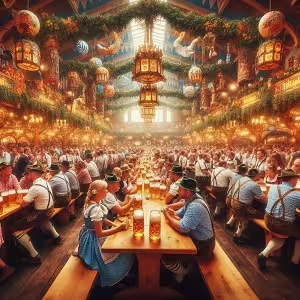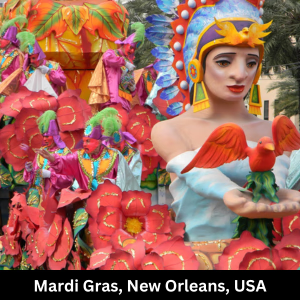Introduction
Who doesn’t want to enjoy a nice festival? During festivals, people come together and celebrate culture and tradition while making memorable moments. From heart-pumping streets in Rio de Janeiro to serene temples in Thailand, such festivals are an insight into the heart and soul of a place. They are trips worth taken, and here are some of the best festival experiences around the world for you to add on your bucket list.
Carnival, Rio de Janeiro, Brazil

A Brief History of Carnival.
Well, the Rio Carnival is among the greatest and most famous carnivals around the world. The event can be traced back to the 18th century when the ritual was introduced into Brazil from immigrants from Portugal. Through the years, it developed as a big festivity with music, dancing, and colorful parades.
Parades and Samba Schools
Samba schools from all parts of Rio participate in carnival’s main attraction – parade. These schools spend many months creating massive floats and costumes apart from perfecting their dance routines. The parade is fierce competition with each school trying to be number one.
Street Party with Costumes
For a more laid-back experience, blocos or street parties are where Carnival’s pulse lies. It is a moment for everyone to don vibrant attire and get involved in dancing along with music that fill up the streets as well as great unity among participants.
Diwali, India

Significance and Origins
Diwali, otherwise known as the Festival of Light, is among the main festivals that the Hindus celebrate. The festival depicts light prevailing over darkness and good winning over evil. Its root can be traced down to ancient Indian literature and mythology, associated with Lord Rama’s homecoming to Ayodhya after 14 years of exile.
Fireworks and Lights
The night sky is ignited with fireworks during Diwali creating an atmosphere of joyousness. Innumerable oil lamps, candles and electric bulbs are used for decorating houses and streets. It is a period when families gather to celebrate and share gifts.
Traditional Foods and Sweets
Any Indian occasion, like Diwali is incomplete without food. Traditional sweets like laddoos, barfis, jalebis are cooked and shared with loved ones. There are also salty snacks or savory items that are prepared during this time in large quantities making it a very sumptuous treat.
Oktoberfest, Munich, Germany

Origins and History.
Oktoberfest started in 1810, initiated by the marriage of Crown Prince Ludwig to Princess Therese of Saxe-Hildburghausen. A wedding fair for royals developed into the biggest beer festival on earth, gathering millions of people every year. And for those who are planning their first trip to Europe, care to check out our Travel Guide to Europe for First-Time Visitors for tips and recommendations to make the most of your journey.
Beer Tents & Breweries
Okay, Oktoberfest’s beer tents are really the center of the festival. Each tent belongs to another brewery, so it has a different atmosphere and, obviously enough, a lot of beer. The beer on hand for Oktoberfest is especial; it is brewed within Munich’s city limits and in accordance with the Reinheitsgebot, or German Beer Purity Law.
Traditional Bavarian Music and Dress
Oktoberfest is not just about beer. There’s plenty of classic Bavarian music, which flows throughout, and many people sport dirndls and lederhosen that really put the happy vibes into the atmosphere. It also features traveling midway rides, several game booths, and plenty of food vendors offering German and non-German food.
La Tomatina, Buñol, Spain

The Tomato Fight Origins
La Tomatina is an annual tomato fight ending in one huge mess. The frenzy began in 1945, where, for no reason at all, a group of young people suddenly started pelting each other with tomatoes on the town square. Today it is the venue for thousands from across the world.
Rules and Safety Tips
Participants should be advised to break tomatoes before throwing them to prevent injuries. The fight lasts about an hour during which time streets get covered with tomato paste by the end of the brawl. Safety glasses must be worn and old clothes should be put on.
Post-festival celebrations
Afterwards the participants can clean off in a near river or use public showers made by the town. The event lasts all day and includes music, dancing, and local cuisine.
Chinese New Year, China

Cultural Significance
The Chinese New Year, otherwise called the Spring celebration, is the most vital customary celebration in China. This is the commencement of the Lunar New Year, portrayed by reunions, paying regards to one’s ancestors, and ushering in great luck.
Lantern Festival
The Lantern Festival marks the very last day of the Chinese New Year. Lanterns are sent up into the sky or set free in rivers to show that they’re sending the old out and bringing the new in. It is such a beautiful view that it is rightly reserved for the last day of celebration.
Dragon and Lion Dance
Dragon and lion dances are customary in a Chinese New Year celebration. The acts are said to bring in good luck, and people of all ages from children to elders like these dances very much. They form the real essence of the festival and are colorful and full of life.
Mardi Gras, New Orleans, USA

History
Better known as Mardi Gras, Fat Tuesday actually originated in medieval Europe before being brought over to the United States by French colonists. New Orleans has become synonymous with Mardi Gras since it hosts one of the most famous festivals for this event in the world.
Parades and floats
Parades are the actual event of Mardi Gras. Scores of great floats parade down the streets, accompanied by marching bands and dancers. From the floats, things like beads, cash, and other items are tossed down to the cheering audiences below.
Masks and beads
Masks and costumes are a tradition with Mardi Gras. It adds mystery and a little excitement to the party. It is a very common hobby to collect the beads, and the more beads you have, the more fun you’ll have!
Holi, India and Nepal

Mythical Roots
Holi, the festival of colors, draws its origin from Hindu mythology. It marks the arrival of spring and is celebrated for the victory of good over evil. The story of Prahlad and Holika forms an essential part of the significance of this festival.
Color Throwing
Holi is famous for color throwing. Gathering in open areas, people throw colored powders and colored water at one another. It is a merry, messed-up sight with peals of laughter and music.
Music & Dance
Music and dance are an important part of the celebrations of Holi. Jalebi tracks are played on loudspeakers, and people dance without any inhibition. The air is so infectious that it becomes very difficult not to join in the celebrations.
The Running of the Bulls, Pamplona, Spain

Historical Setting.
The city of Pampolna, is the city where Running of the Bulls event take place. It dates back to the 14th century, when this event gained worldwide popularity, I would say, partly through the novel of Ernest Hemingway, “The Sun Also Rises.“
The Bull Run
Every morning of the festival, brave – or senseless – people run along the course with a dozen bulls every morning. The 825-meter run ends in the bullring. It’s indeed an exhilarating but dangerous event witnessed by thousands.
Traditional Attire and Songs
Runners are usually attired in white clothing with a red bandana and a red belt. Traditional songs are sung before the run ensues, which adds to the sense of togetherness and expectancy among the runners.
Songkran, Thailand

Cultural Significance
Songkran is a statewide water fight, also known as Thai New Year. This is to wash away literally all misfortunes of the past year and start the new one afresh.
Water fights
During Songkran, streets become a battleground for people’s water fights. The spilling or pouring of water is usually done using buckets, water pistols, and hoses. It is a friendly and refreshing way to cool off during the New Year celebration.
Religious Ceremonies
Songkran, among others, is the more somber side of things with water bouts. The people pay homage to temples, give food to monks, join in traditional funs and festivities. This is the time for reflection and respect for elders.
Conclusion
From the colorful chaos of Holi to the tranquil lanterns of Chinese New Year, the best festivals experiences around the world taken into other cultures and traditions is definite. The events fill hearts with joy, forge communities together, and offer truly unforgettable moments. So, pack your bags, let wanderlust take over, and treat yourself to these amazing festivities.
FAQs
When is the best time of the year for these festivals to take place?
The best time to go is different in each case. For instance, Rio’s Carnival occurs in February, while Diwali normally happens in October or November, and Oktoberfest from the middle of September until the first weekend of October.
Are these festivals suitable for children?
Many of these festivals, such as Diwali and Chinese New Year, are family affairs. Others, like Running of the Bulls, are not at all suitable for younger children, given the safety challenges involved.
What shall I wear to all these festivals?
Remember to pack comfortable clothes, good shoes, and anything specific for the festival—like costumes for Carnival or waterproof gear for Songkran. And don’t forget your camera in order to capture those special moments!

